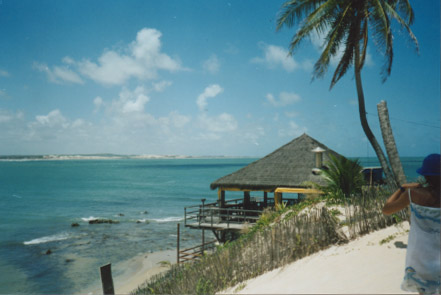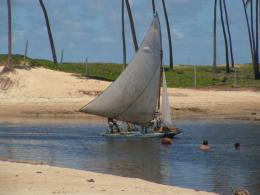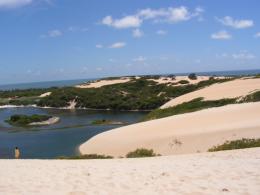|
Natal - Brazil |
|
Destinations |
 |
 |
 |
Located in the
Northern region of Mato Grosso State, 520 km (323 miles) from Cuiabá,
Feliz Natal preserves all its natural beauty and maintains its local
culture alive through the Xingu Indian National Park.
Xingu is the 3rd largest Indian park in Brazil and the world. It has
an area of approximately 2,800,000 hectares, with a current
population of 5,000 Indians, distributed among 204 tribes and 16
ethnic groups.
The town’s biggest attraction is ecotourism, which offers the
possibility of contact with untouched nature in the Amazonas region.
It is also possible to learn about part of the Brazilian Indian
history and culture.
Another worthwhile program is the Xingu Itinerary and a visit to the
Waurá and Trumai village. Visitors are received by the Indians
themselves and are invited to watch dances and other rituals, learn
about Indian history and legends, and participate in the tribe’s
daily life. It is a four-day trip.
The tour through the Mata Atlântica reveals vast rivers and views
that give one the impression of being in the same place, no matter
how far one has travelled or walked.
-
Basic information
-
Climate
It has a tropical humid climate, with a short dry season and an
average annual temperature of 27°C (80ºF).
-
-
City facts
-
Feliz Natal
State: Mato Grosso
Region: Midwest
Population: 4,005 inhabitants
Area Code: (65)
Distances
Cuiabá: 521 km (324 miles)
Campo Grande: 1329 km (826 miles)
Brasília: 1663 km (1034 miles)
Rio de Janeiro: 2645 km (1644 miles)
-
-
Accommodation /
Restaurants
-
The best hotel in
Feliz Natal is the Xingu Amazonas Refuge, located inside Indian
Territory. It also offers tours through the region. Its
accommodations are comfortable, and it provides intense contact
with nature. The restaurants are simple, just like the town. The
region’s typical dishes are served in huge servings. It is
possible to eat very well and spend very little.
-
-
How to get there
-
By Air: The
closest airport with regular flights is the Marechal Rondon, in
Cuiabá. From Cuiabá, continue for 521 km (324 miles) along BR
364 and BR 163.
By Highway:
Main access roads:
Starting from Cuiabá: BR-364 / BR-163
Starting from Campo Grande: BR-163 / BR-164
Starting from Brasília: BR-060 / BR-070 / BR-364 / BR-163
Starting from Rio de Janeiro: BR-116 / BR-364 / BR-163
-
-
Services
-
Town Hall: +55
(65) 585-1124/1150
Bank Branches
The town only has Bank of Brazil and CAIXA branches. Very few
establishments accept credit cards.
-
-
Attractions
-
Xingu Amazonas
Refuge
The Xingu National Park encompasses 19,000 hectares that have
been transformed into a Private Natural Heritage Reserve.
Whoever has the privilege of visiting it can follow trails and
enjoy the most beautiful plants and animals in the Amazon
Forest, besides living with the Waurá and Trumai Indians, on
expeditions.
Sport fishing is also practiced there. The differential in this
activity is the use of Indian techniques to locate and capture
fish. Besides trails and fishing, it is also possible to take a
wonderful tour in a rowboat along the Von den Steinen river, an
important affluent of the Xingu River Basin. The landscape along
the rivers is beautiful and calm, just like its waters.
The most daring tourists will be able to spot and closely follow
alligators along the Von den Steinen River.
Xingu Indian Park
This is a 2,642,003-hectare area with great biodiversity. It is
a transition area of savannahs and dryer semi-deciduous forests,
to the south, and the Amazon Rainforest to the north. It has
thick forests, fields, holm tree forests, dry land forests, and
forests in the Archeological Black Soil.
The Xingu can be divided into three regions: one to the north
(known as the Lower Xingu), one in the central area (the Mid
Xingu) and another to the south (the High Xingu). In the south
there are the tributaries that form the Xingu River; the central
area goes from the Morena (the convergence of the Ronuro, Batovi
and Kuluene Rivers) to Grande Isle; the Northern part of the
park follows the course of the Xingu River.
In the High Xingu there are people who are culturally very
similar, whose ethnic groups are served by the Leonardo Villas
Boas Indian Post. The Trumai, Ikpeng and Kaiabi, in the Mid
Xingu, are served by the Pavuru Post. To the north, the Suyá,
Yudjá and Kaiabi are served by the Diauarum Post. Each post
supports the logistics for projects and activities developed in
the Park, such as education and health.
The rivers that form the Xingu River are also to the south of
the Park, and they comprise a river basin that is drained by the
Von den Stein, Jatobá, Ronuro, Batovi, Kurisevo and Kuluene
Rivers. The latter is the Xingu’s main tributary as it meets the
Batovi and Ronuro Rivers.
|
|